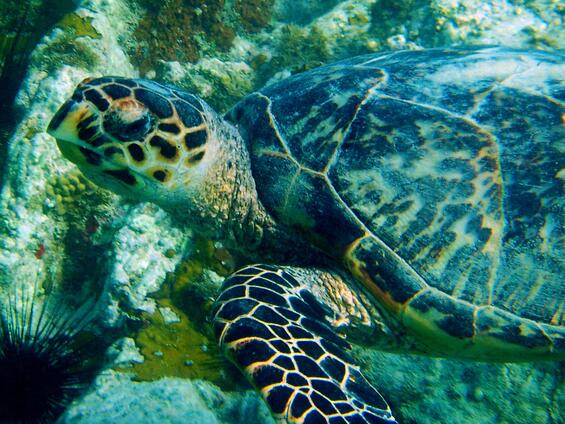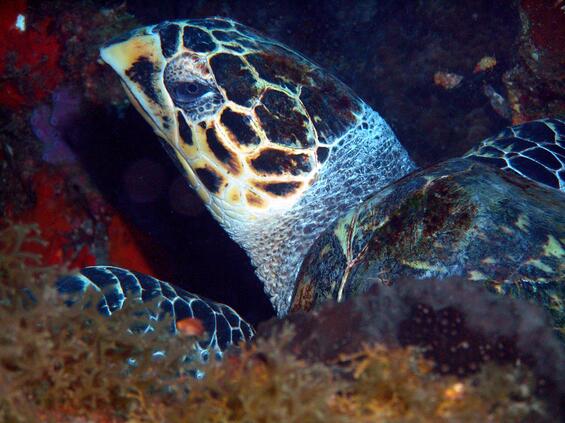- Scientific name: Eretmochelys imbricata
- Species of Greatest Conservation Need (MA State Wildlife Action Plan)
- Endangered (MA Endangered Species Act)
- Endangered (US Endangered Species Act)
Description

Adult hawksbill sea turtle. Photo by Becky A. Dayhuff. Courtesy NOAA.
The hawksbill sea turtle (Eretmochelys imbricata) is a tropical species seldom encountered in the North Atlantic. The native status of the hawksbill in Massachusetts is highly questionable, although occasional individuals may naturally occur infrequently. Hawksbills are named for their prominent, raptor-like beak. Their brown shell has been described as “shield” shaped and is distinctive because of ornate, overlapping scutes (keratinous plates) and a serrated rear margin. Young hawksbills have a heart-shaped carapace. The ornate pattern of the carapace can be obscured by algae as turtles age. Hawksbills have more narrow heads in comparison to loggerhead sea turtles (Caretta caretta) and green sea turtles (Chelonia mydas). Adults are about 76–90 cm (30-35 in) long but can reach a maximum size of 114 cm (44 in) and weigh 45–68 kg (100–150 lb).
Similar species
The hawksbill is extremely rare in Massachusetts and its natural or native occurrence, at present, is questionable. For this reason, it is unlikely to create confusion with other hard-shelled sea turtle species. Adult hawksbills are typically smaller than loggerheads and green sea turtles, but larger than the Kemp’s ridley sea turtle (Lepidochelys kempii). Like the loggerhead, hawksbills have two pairs of prefrontal scutes on top of its head, between the eyes. The hawksbill also typically has two claws on each front flipper, unlike the other hard-shelled sea turtles, which have one. Hawksbills can be told from loggerheads and Kemp’s ridleys (but not green sea turtles) by the presence of only four costal scutes on the carapace.
Life cycle and behavior

Close-up of the head of a hawksbill sea turtle. Photo by Emma Hickerson, Flower Garden Banks National Marine Sanctuary.
The maximum potential lifespan of the hawksbill sea turtle is unknown, but is expected to exceed 50 years based on an analysis of cytosine-phosphate-guanine (CpG) density. Young hawksbills grow very fast: wild turtles are estimated to reach 60 cm (23 in) by the end of their third year and may even become mature by their third year in Costa Rica. Adult females return to the beach where they were born every 2 to 3 years to lay eggs at intervals of every 14 to 16 days during the nesting season. Female hawksbills lay several nests per season, each with around 130 eggs. Nesting generally occurs at night between April and November. Incubation time is around 2 months. After hatching, emerging from the nest, and entering the sea, juveniles find shelter in floating algal mats, flotsam, and jetsam.
Distribution and abundance
Hawksbill sea turtles inhabit mostly tropical waters—from about 30°N latitude to 30°S latitude—in the Atlantic, Pacific, and Indian Oceans. Most the species’ nesting sites are found along the Pacific Rim and central Pacific. In the Atlantic Ocean, hawksbills nest primarily in the Caribbean. Otherwise, hawksbills’ movement patterns are similar to those of the green and loggerhead sea turtles, which can travel exceptional distances between nesting and foraging habitat. The natural occurrence of hawksbill sea turtles in Massachusetts in unlikely, and nothing is known about individuals in Massachusetts waters.
Habitat
Hawksbill sea turtles are the most tropical of the four species of sea turtle reported from the North Atlantic; it is seldomly reported north of Florida. The hawksbill is an iconic species of tropical and subtropical coral reefs, where it feeds mostly (and sometimes exclusively) on sponges, but also algae, and invertebrates. In some areas, hawksbills may influence the structural composition of coral reef communities by their foraging habits. Only three dead individuals have been reported from Massachusetts—all from Cape Cod—in 1909, 1968, and 1989.
Healthy habitats are vital for supporting native wildlife and plants. Explore habitats and learn about conservation and restoration in Massachusetts.
Threats
Hawksbill sea turtles are threatened by numerous well-documented factors throughout their range, including boat strikes, entanglement in fishing gear, decline and degradation of coral reefs, degradation of nesting beaches by recreational activity, nest depredation by vertebrate and invertebrate predators, and illegal collection of eggs, meat and tortoiseshell. Because the species is unlikely to occur with any regularity in Massachusetts, the threats faced by other sea turtles in Massachusetts waters are probably not a significant factor influencing hawksbill populations.
Conservation and management
As noted above, it appears unlikely that native or naturally-occurring hawksbills are a regular occurrence in Massachusetts. Nevertheless, individuals that might occur naturally in Cape Cod Bay, Vineyard Sound, or Nantucket Sound will likely benefit from management programs in place for Kemp’s ridleys, loggerheads, and green sea turtles which have focused on managing cold-stunned turtles found mostly on Cape Cod Bay in late fall and winter. Sea turtles (of any species) found on northeastern beaches—dead or alive—should be reported immediately to one of the marine animal stranding networks noted below.
- Wellfleet Bay Wildlife Sanctuary’s Sea Turtle Hotline: (508) 349-2615, option 2
- NOAA Fisheries Marine Animal Hotline: (866) 755-6622
- New England Aquarium’s Marine Animal Hotline: (617) 973-5247
- Provincetown Center for Coastal Studies’ Disentanglement Hotline: 800-900-3622 (mostly to disentangle leatherbacks)
References
Ernst, C.H., and J. Lovich. (2009). Turtles of the United States and Canada. Johns Hopkins University Press; Baltimore.
Komoroske, L.M., M.P. Jensen, K.R. Stewart, B.M. Shamblin, and P.H. Dutton. (2017) Advances in the application of genetics in marine turtle biology and conservation. Front. Mar. Sci. 4:156
Mayne, B., A.D. Tucker, O. Berry, and S. Jarman. 2020. Lifespan estimation in marine turtles using genomic promoter CpG density. PLoS ONE 15(7):e0236888.
Wyneken, J., Lohmann, K., and Musick, J. A. (2013). The Biology of Sea Turtles, Vol. 3. Boca Raton, FL: CRC Press.
Contact
| Date published: | April 2, 2025 |
|---|